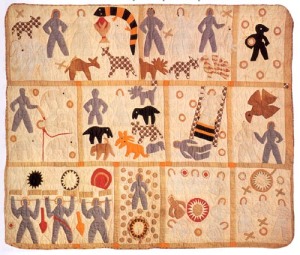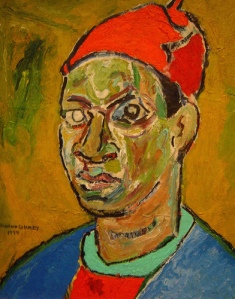This week is ART! Well, artists, to be exact. As in the previous weeks, this wasn’t such an easy task. So I started with those born in the later part of the 1800s and will go through the 1970s, taking each day to focus on about a 20-30 year block. Also, as in the previous weeks, I feel like I don’t do justice to these phenomenal African American artists so I sort of picked at random and if the art grabbed me, and the artist fit in the decade of the day, I chose him/her. I did try to focus on women artists.
Today I have six artists I will present instead of the usual three. I hope you like the picks.
1. Harriet Powers (1837-1910)
Harriet Powers was a slave, folk artist and quilt maker born on October 29, 1837 in Georgia. As often was tradition, she used quilts to record local legends, Bible stories and astronomical events. Only two of her quilts have survived and are used as examples of 19th Century Southern quilting. Her work is on display at the National Museum of American History in Washington D.C. and at the Museum of Fine Arts in Boston, MA. (For more information, please visit here.)
Here is one of two of Powers’ surviving quilts titled Bible Quilt, mixed media, 1886:
And here is the other surviving quilt titled Pictorial Quilt, mixed media, 1898:
2. Mary A. Bell (1873-1941)
Born July 2, 1873 in Washington, D.C. and, unfortunately, not much of her early life is known. She worked menial jobs when young and received no formal training. She was in her sixties when her crayon artwork became known to the general public, thanks to author Gertrude Stein, writer and photographer Carl Van Vechten, publicist Mark Lutz, critic Henry McBride and artist Florine Stettheimer. Her drawings depict scenes from the everyday life of the rich, as well as Creole or African American subjects. Bell was troubled by mental illness and was committed to a mental health facility in Boston in 1940, a year before she died from heart failure. Personally, I found her art fascinating and somewhat reminiscent of Picasso. (For more information, please visit here.)
Here is Bell’s artwork titled The Lost Chord:
And here is Bell’s artwork titled American Mixtures of the Ethiopian Race:
3. Palmer C. Hayden (1890-1973)
Born on January 15, 1890, Palmer C. Hayden was a painter who depicted African American life, one of the first in America to do so. He always wanted to be a fiddle player and his whole life regretted never pursuing this dream. His family couldn’t afford a fiddle and he later was too timid to try and become one. When he began to pursue a career in art, he encountered racism when seeking to become an artist’s assistant and not getting the job because he was black. He would work various jobs while pursuing art and would eventually reach success and popularity in Europe, where he studied in Paris, before gaining any kind of recognition in the U.S. Most of Hayden’s work after Paris focused on the African American experience capturing rural life as well as urban backgrounds in New York City, usually set in Harlem. He died on February 18, 1973. (For more information, please visit here.)
Here is Hayden’s piece titled People Who Studied Abroad #349:
Here is Hayden’s piece titled Baltimore:
4. Aaron Douglas (1898-1979)
Born on May 26, 1898 in Topeka, Kansas, Douglas moved to New York City after college and settled in Harlem. He was a major figure in the Harlem Renaissance. His work during the 1930s is considered to be his most important and include his murals at Fisk University and at the 135th Street Branch of the New York Public Library (now the Schomburg Center for Research in Black Culture). In 1939, he moved to Nashville, TN where he founded the Art Department at Fisk University and taught there for 27 years. His art shifted to a more traditional painting style, including portraits and landscapes. (For more information, please visit here.)
Here is Douglas’ Harriet Tubman Mural (1930-31):
Here is Douglas’ painting Power Plant, Harlem, 1939:
5. Beauford Delaney (1901-1979)
Born on December 30, 1901 in Knoxville, TN, Beauford Delaney to a prominent and respected family in Knoxville’s black community. He showed an interest in art at an early age, constantly drawing. At 23, he moved north to Boston to study art and eventually settled in Harlem at the time of the Harlem Renaissance. He would use members of Harlem, a disenfranchised community, as his subjects. In 1953, at the age of 52, Delaney moved to Paris and remained in Europe until his death in 1979 He suffered from mental illness, as well as alcohol abuse, and was eventually committed to St. Anne’s Hospital for the Insane in Paris where he died on March 26, 1979. (For more information, please visit here.)
Here is Delaney’s Can Fire in the Park (1946), considered to be work that vacillates between “representation and abstraction;” a style that evolved during the 1940s:
And here is Delaney’s Self-Portrait, oil on canvas, 1944:
6. Mildred Thompson (1936-2003)
Mildred Thompson was born in 1936 in Jacksonville, FL and her formal art training began in 1953 at Howard University in Washington, D.C. She would later study in Germany at the Art Academy of Hamburg where she and her art were well-received. Back in the U.S., she didn’t get the social and artistic acceptance she did in Germany and was refused shows and exhibitions because she was black. She returned to Germany. In 1975, she returned to the US and the social climate had somewhat changed for black artists. After a brief return to Paris in 1981, she moved to Atlanta, GA in 1986 where she remained until she died. (For more information, please visit here.)
I’m not sure if I have the correct titles of the artwork I chose because the information is very spotty, but I’m giving what is written next to the art. Here is Thompson’s Music of the Spheres: Jupiter:
Here is Thompson’s Stock Photo #1147-359, Heliocentric:











